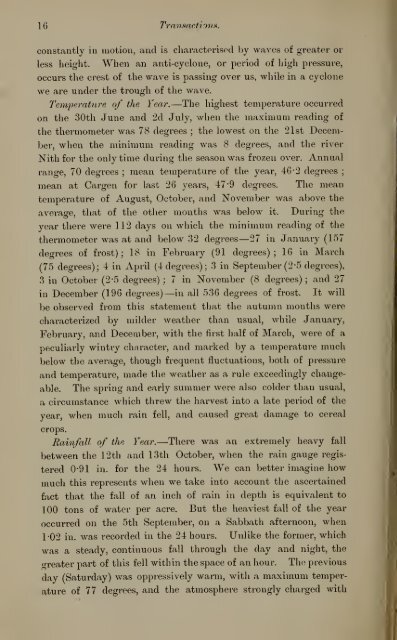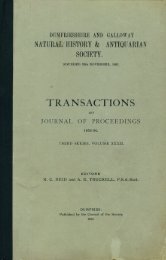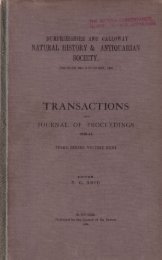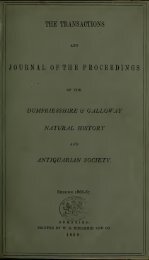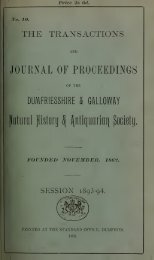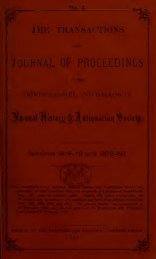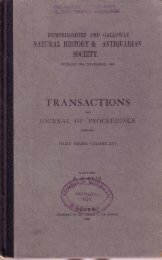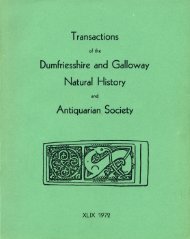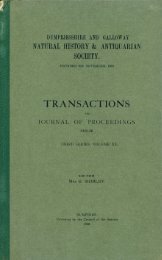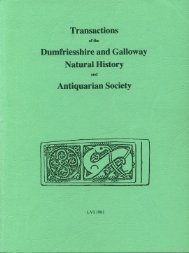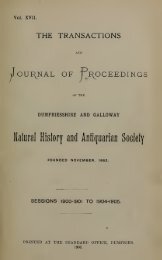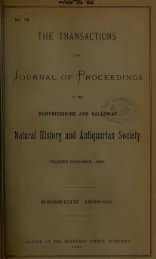61Trani^nctionH.constantly in motion, <strong>and</strong> iscliaracterisod liy waves of greater orless height. Wlien an anti-cyclone, or period of high pressure,occurs the crest of the wave is passing over us, while in a cyclonewe are under the trough of the wave.Tetnperattore of the Year.—The highest temperature occurredon the30th June <strong>and</strong> 2d July, when the maximum reading ofthe thermometer was 78 degrees ;the lowest on the 21st December,when the minimum i-eading was 8 degrees, <strong>and</strong> the riverNith for the only time during the season was frozen over. Annualrange, 70 degrees ; mean temperature of the year, 46-2 degrees ;mean at Cargen for last 26 years, 47"9 degrees. The meantemperature of August, October, <strong>and</strong> November was above theaverage, that of the other months was below it. During theyear there were 112 days on which the minimum reading of thethenuometer was at <strong>and</strong> below 32 degrees— 27 in January (157degrees of frost); 18 in February (91 degrees); 16 in March(75 degrees); 4 in April (4 degrees); 3 in September (2-5 degrees).3 in October (2-5 degrees) ;7 in November (8 degrees) ; <strong>and</strong> 27in December (196 degrees)—in all 536 degrees of frost. It willbe observed from this statement that the autumn months werecharactei'ized by milder weather than usual, while January,February, <strong>and</strong> December, with the first half of March, were of apeculiarly wintry character, <strong>and</strong> marked by a temperature muchbelow the average, though frequent fluctuations, both of pressure<strong>and</strong> temperature, made the weather as a rule exceedingly changeable.The spring <strong>and</strong> early summer were also colder than usual,a circumstance which threw the harvest into a late period of theyear, when much rain fell, <strong>and</strong> caused great damage to cerealcrops.Rainfall of the Year.—There was an extremely heavy fallbetween the 12tli <strong>and</strong> 13th October, when the rain gauge registered0-91 in. for the 24 hours. We can better imagine howmuch this represents when we take into account the ascertainedfact that the fall of an inch of rain in depth is equivalent to100 tons of water per acre. But the heaviest fall of the yearoccurred on the 5th September, on a Sabbath afternoon, wlien1 -02 in. was recorded in the 24 hours. Unlike the former, whichwas a steady, continuous fall through the day <strong>and</strong> night, the"reater part of this fell within the space of an hour. The previousday (Saturday) was oppressively warm, witli a maximum temperatureof 77 degrees, <strong>and</strong> the atmosphere strongly charged with
7'ransactions. 17electricity. Some rain fell on Sabbath morning, but it was nottill three o'clock in the afternoon that the downpour commencedin right earnest. At that hour there was a sharp shower, followed,after a brief cessation, by a tremendous torrent of rain,accompanied by numerous peals of thunder <strong>and</strong> flashes of lightning,<strong>and</strong> shortly after by a high wind, the noise of which almostdrowned the sound of the thunder, <strong>and</strong> the sky at the same timegrew so dark that it was hardly possible to see to read. Thedrains being insuflicient to carry ofl" the great body of watei' whichfell in so short a space of time, many of the streets <strong>and</strong> roadways ofthe town <strong>and</strong> suburbs, <strong>and</strong> of the areas <strong>and</strong> cellars in low-lying parts,were flooded to a considerable depth.The storm appears to havebeen more severely felt on the shore of the Solway Firth, particularlyin the neighbourhood of the Brow Well, than furtherinl<strong>and</strong>. The following description, given in the St<strong>and</strong>ard newspaperat the time, is worthy of being quoted :— " Before theheaviest of the rainfall, a hurricane was observed suddenly tospring up, apparently about Southerness Point, <strong>and</strong> drive massesof cloud before it in the direction of Silloth. The sight was oneof terrific gr<strong>and</strong>eur, so rapidly did the clouds speed along, <strong>and</strong> sotumultuously did they roll over each other. When near to Silloth,the storm seemed suddenly to veer, <strong>and</strong> swept across the channel<strong>and</strong> inl<strong>and</strong> in a north-westerly direction. The roar of the windwas heard a considerable time before its force could be felt, <strong>and</strong>then the few persons who were out found it impossible to st<strong>and</strong>against it, <strong>and</strong> were fain to lay themselves prostrate. The rarephenomenon of a water spout was also witnessed. The water waslashed up into a tapering column, described to us as having beenhigher than the Midsteeple ofDumfries, <strong>and</strong> this careered alongin a threatening manner, but it gradually subsided without anymischievous result, finally disappearing a little to the north ofLadyl<strong>and</strong>, a farm about two miles from Clarencefield."The wettest month of the year was September, with a fall of5 -79 in., being 3-5 in. above the average. The driest month wasJune, when the total fall was only 0-77 in. There were 224days on which precipitation took place inone form or other, buton 25 of these the fall did not exceed one hundredth of an inch.There were 18 on which snow fell, <strong>and</strong> 206 rain— total rainfallfor the year, 40-63 in. ; mean of 26 years at Cargen, as reportedby Mr Dudgeon, 44-85 in. The average rainfall for Dumfries,according to a table given in Sir John Herschell's article on3
- Page 1: THE TRANSACTIONS•^^g^feJOURNAL OF
- Page 4 and 5: —" How charming is Divine Philoso
- Page 6 and 7: ——————CONTENTSPaficSecr
- Page 8 and 9: I2 Transactions.crops in the old wo
- Page 10 and 11: 4 Transactions.Glasgow Geological S
- Page 12 and 13: —Transactions.5th November, 1886.
- Page 14 and 15: I8 Transactions.and is very irregul
- Page 16 and 17: \10 Tronmrtiotis.jig ; H. cracatum
- Page 18 and 19: 12 Transactions.the rebellion of 17
- Page 20 and 21: ..14 Transactions.Society were acco
- Page 24 and 25: 8;1Transactions." Meteorology," in
- Page 26 and 27: —20 Tra/HsactioHS.Provost or Alde
- Page 28 and 29: 22 Traitsactions.Scotland, as in th
- Page 30 and 31: —24 Transactions.the Lower orWlii
- Page 32 and 33: 26 Transactions.long supported and
- Page 34 and 35: Languendo,—28 Transactions.Uh Mar
- Page 36 and 37: DeiMag30 l^ranadtctiond.wood, shape
- Page 38 and 39: 32 Transactions.in the sea for the
- Page 40 and 41: 34 Transactions.a good deal here. I
- Page 42 and 43: 36 Tran.sactions.not run by day, bu
- Page 44 and 45: ;38 Transactions.\st April, 1887.Dr
- Page 46 and 47: 40 Transnctio7is.guessed it to be o
- Page 49 and 50: —Transactions. 41ancient British
- Page 51 and 52: —Transactions.'43as the Milton Pa
- Page 53 and 54: IWansactions. 46one I have noticed
- Page 55 and 56: —Transactions 47Some two hundred
- Page 57 and 58: •~?lATt. 1 =^YPr 1.© © ©€* e
- Page 59: Tlats H .HOMPSON ,S;^TONE'Photo -Ti
- Page 63: -RZZ-TlATX- IT.^T••MiGH BRINKSS
- Page 67: TiATE^ITHt: CiAcHANliOLU STONE(BOBG
- Page 71 and 72: —Trannactions. 49type.But its fel
- Page 73 and 74:
Transactioiis. 51portion which is d
- Page 75 and 76:
Transactions. 53considerable length
- Page 77 and 78:
—TransartionR. 55The genus Didymo
- Page 79 and 80:
Transactions. 57while Mr Carruthers
- Page 81 and 82:
Field Meetings.59From the churchyar
- Page 83 and 84:
Field Meetings. 61was obtained. lu
- Page 85 and 86:
—Field ^feetin
- Page 87 and 88:
—Field Meetings.'65levying; duos.
- Page 89 and 90:
Field Meeting8. 67ings in the neigh
- Page 91 and 92:
Appendix.G'JNATURAL HISTORY DIVISIO
- Page 93 and 94:
—Apprndix. 71smaller birds— by
- Page 95 and 96:
wlio was an honorary burgess of the
- Page 97 and 98:
— —Appr.ndix. 75—R. B."Table,
- Page 99 and 100:
Appendix. 77James Litiljohne, &c.,
- Page 101 and 102:
——;Appevi/ix. 79Manuscripts.
- Page 103 and 104:
—"——Appendii: 81Thomas Huttou
- Page 105 and 106:
——— ——————Appendi
- Page 107 and 108:
APPENDIX B.LIST OF MEMBERS OF THE S
- Page 109 and 110:
,,,5th Nov.,3d Fel>y.,5th July,•2


